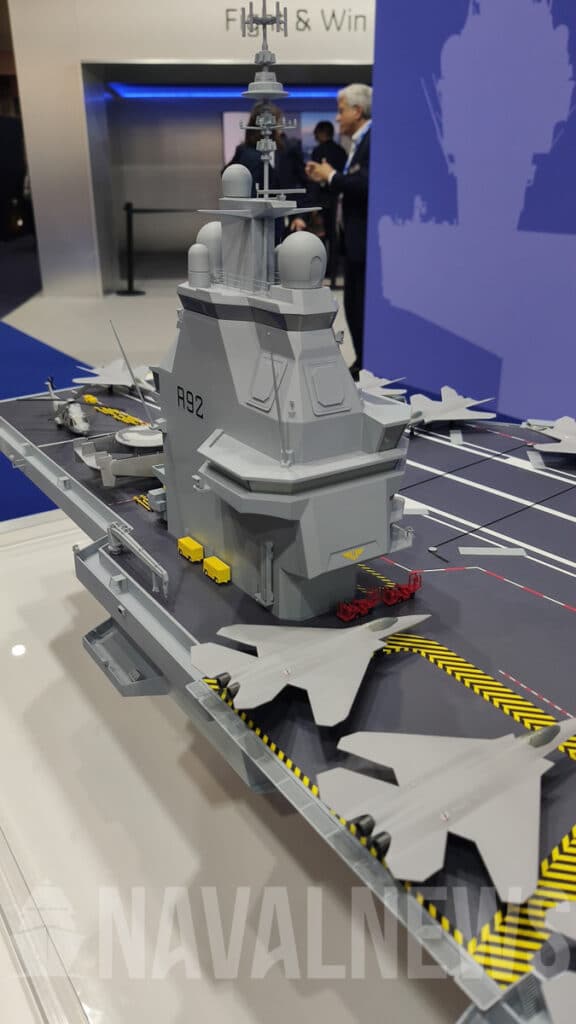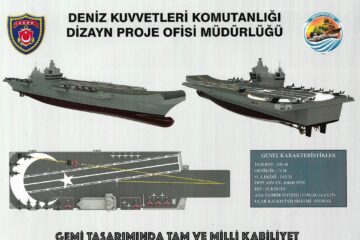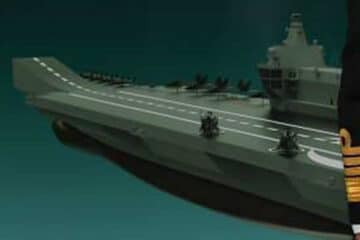The most striking evolution in the design is on the island of the carrier. Its general shape has evolved quite significantly compared to the initial design unveiled in 2020: While it used to be shaped like a “water drop”, it is now more more “square”. The bridge design has change, as well as the mast. While the new model on display at Euronaval still features the SeaFire radar (in four fixed pannels configuration), the “cone” at the top of the island is gone to make way for an array of domes for satellite communication.

Behind the island, there is now a helicopter spot as well as an area to conduct aircraft maintenance on the flightdeck.
While less noticeable, the shape of the flightdeck has evolved too. Naval News was told the modifications were made so that the design would better accommodate a third EMALS, should it be needed.
For self protection, the new PANG scale model now features a numbers of SIMBAD-RC, RapidFire CIWS, VLS for Aster missiles and the new CMLS anti-torpedo decoy launchers.

French President Emmanuel Macron officially green lighted the construction of a new nuclear-powered aircraft carrier as part of the PA-Ng program one year ago (8 December 2020). The future flagship of the Marine Nationale is intended to replace the existing Charles de Gaulle around 2038.
During the Euronaval 2022 press trip last month, the PANG program manager at DGA (Directorate General of Armaments) shared some up-to-date details on the program.

PANG latest specifications
The latest technical specification of France’s future aircraft carrier are as follow (preliminary design data):
- Full load displacement: ~ 75,000 t
- Overall length: 310 m
- Length at waterline: 305 m
- Width at water line: 39 m
- Flight deck surface area: ~ 17,000 m²
- Max draught: 10.8 m
- Two or three 90-meter electromagnetic catapults (EMALS) by General Atomics
- Airwing: ~30 New Generation Fighter (NGF) and Rafale M
- Maximum speed: 30 knots (more than Charles de Gaulle)
Regarding the configuration of the weapon systems (VLS for Aster 15 or 30?) and sensor systems (SeaFire radar with fixed panels or rotating?), DGA is still considering a range of options, and nothing is yet “set in stone”. The design requirements, however, call for sufficient power margins in order to accommodate directed energy weapons.
PANG program workshare
Here is how work on the PANG is shared between the different entities taking part in the program:
- Both the DGA and CEA (Atomic Energy Commission) act as contracting authority.
- MO Porte-Avions (joint company by Naval Group [65%] and Chantiers de l’Atlantique [35%]) and TechnicAtome are in charge of the overall program management.
- TechnicAtome is the prime contractor for the nuclear reactors.
- MO Porte-Avions is the prime contractor for the whole vessel (excluding the nuclear reactors).
- TechnicAtome is in charge of the new nuclear reactor architecture, installation and equipment.
- Naval Group is in charge of:
- The assembly of the nuclear reactors and auxiliary capacities,
- The production of main reactors capacities,
- The whole warship architecture
- The aviation facilities and combat systems
- The power conversion systems
- Chantiers de l’Atlantique is in charge of the platform production and the ship assembly.
PANG program schedule
Technical and operational studies started in 2018 and ended in 2019. In parallel, the conceptual design started at the end of 2018 and ended in December 2019.
The PANG program is currently in the “risk mitigation & innovation studies”. They started in January 2021 and are set to end in December 2023. At the same time, “preliminary design studies” started in Q1 2021 and are set to end in Q1 2023.
The “definition phase” will start from Q2 2023 and last until December 2025 with the “system functional review” milestone.
The decision to launch the development and production phase is due for end of 2025 / early 2026, after which the “development and production” phase will span 10 years (2026 until 2036). Several milestones are set to be achieved in this timeframe:
- Preliminary design review in Q4 2028
- Critical design review in Q4 2029
- First sea trials: End of 2035 / early 2036
- Delivery: End of 2036 / early 2037
- Commissioning: End of 2037 / early 2038
The production & construction phase will start in early 2031 in St Nazaire. The PANG will then transfer to Toulon in mid-2035 to finish outfitting work until the end of 2036.
Regarding the transfer from St Nazaire to Toulon: Since Chantiers de l’Atlantique is not a nuclear shipyard, fueling of the nuclear core and divergence (first power up of the reactor) will take place in Toulon. According to the DGA program manager, the plan is to temporarily fit several diesel generators in the hangar (or on the flight deck) of the aircraft carrier in order to provide the electric propulsion system of the carrier with enough power. In other words, this initial transit (which will not be a sea trial) will be conducted with the vessel’s own power, just not nuclear power.
A second PANG remain a possibility
Asked by Naval News about the deadline after which placing an order for a second aircraft carrier would not be possible, the DGA program manager explained:
“There is not really a deadline, because it depends on the French Armed Forces needs. Today there is no deadline and a second PANG remains a possibility.”
PANG program manager at DGA
Two or three EMALS?
The question of how many EMALS catapults for the PANG is still under investigation under investigation according to the DGA program manager:
“The question is between two or three. In our discussions with the Americans, we have an option for a third one. We are currently assessing the operational benefits of course but also integration issues as well as cost issues.”
PANG program manager at DGA






